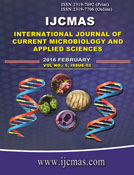


 National Academy of Agricultural Sciences (NAAS)
National Academy of Agricultural Sciences (NAAS)

|
PRINT ISSN : 2319-7692
Online ISSN : 2319-7706 Issues : 12 per year Publisher : Excellent Publishers Email : editorijcmas@gmail.com / submit@ijcmas.com Editor-in-chief: Dr.M.Prakash Index Copernicus ICV 2018: 95.39 NAAS RATING 2020: 5.38 |
The study describes the extraction, fractionation and antimicrobial activity of Cistanche tubulosa. The plant crude methanolic extract and all sub fractions (n-hexane, chloroform, ethyl acetate, n-butanol and aqueous) were subjected to antibacterial and antifungal activity. Agar well diffusion method was used for antimicrobial activities. Methanolic extracts of C. tubulosa show widest zone of inhibition (8mm) and ethyl acetate (7mm) against P. mirabilis using agar well diffusion. Hexane fraction show interesting results of abrupt change in inhibition showing 7mm at 4mg/mL and 1.5mm at 2mg/mL concentration. We got some interesting results from chloroform fraction against K. pneumoniae showing 2mm inhibition at 2mg/mL and 4mm at 1mg/mL concentration. Same against P. mirabilis by hexane fraction showing 3.1mm at 2mg/mL and 4mm at 1mg/ml concentration. The aqueous fraction show inhibition of 7.1mm against E.coli. In antifungal activity methenaol, aqueous and hexane fractions show no inhibition at 1mg/mL concentrataion against A.fumigatus. So the MIC values of these three fractions is 2mg/mL against A.fumigatus. Highest activity fraction was butanol which gives wider zone of 7mm against A. fumigantus. Whereas the same MIC value of methanol extract is 2mg/ml against A.niger. The results established a good support for the use of C. tubulosa in traditional medicine.
 |
 |
 |
 |
 |